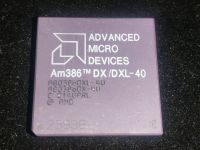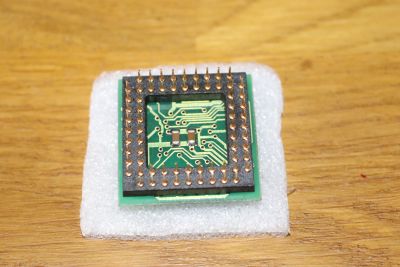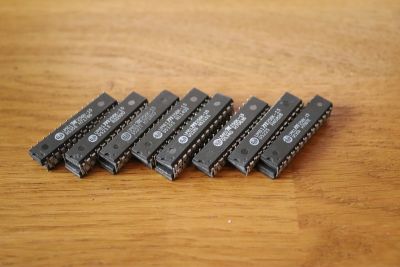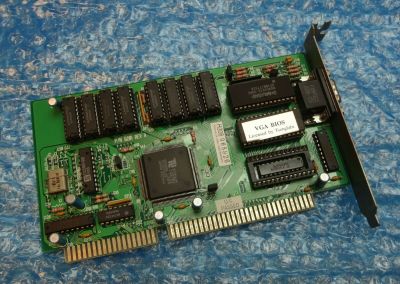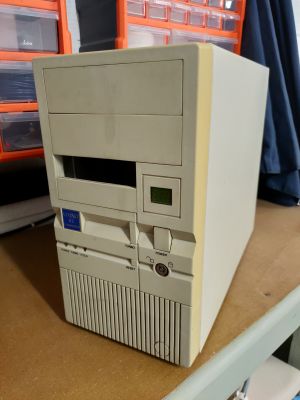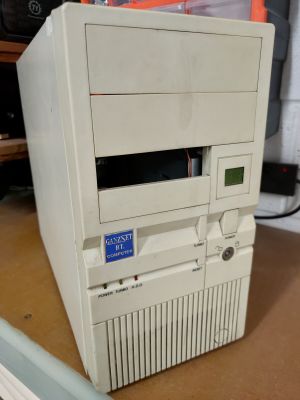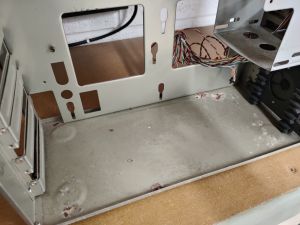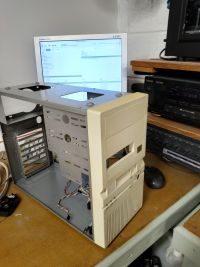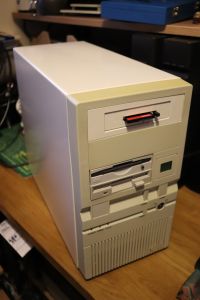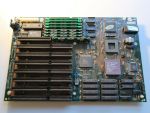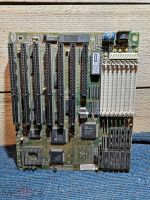Table of Contents
386 PC Adventures
I briefly owned a 386 in the early-mid 1990's, but compared to the memories associated with my first PC; a 286, and the length of time I used the following PC, a 486-DX2, it never held any special memories for me.
In early 2021 I came across a coupe of dirt cheap 386 motherboards that I thought it would be worth trying to get running, all for about the some cost as a takeaway burger meal.
Collecting Parts
Processors
AMD Am386DX/DXL-40
This is a new purchase (Feb 2021).
Some of the motherboards I'll be wanting to test will have soldered-on Am386DX-40 processors, but others are socketed, so I need a consistent baseline to benchmark against. This means the same 40MHz 386DX.
The AMD Am386DX-40 was the fastest 386 processor available at the time. Cyrix and Texas Instruments (see below), as well as IBM, made 486 processors that worked on 386 boards, but they were internally using the 486 instruction set.
Texas Instruments TX486DLC-40
This is a new purchase (Feb 2021).
The TX486DLC is a licensed copy of the Cyrix Cx486DLC; that is to say it is:
- Using the 486 instruction set in a 386DX package
- Has 1KB of on-chip level 1 cache
It will be a nice test for those boards which are socketed to see the performance delta of just changing the processor and keeping everything else the same.
Texas Instruments TX486SXL-40
The Ti 486SXL-40 is identical to the TX486DLC except it has 8KB of level 1 cache, the same as a full Intel 486, instead of just 1KB.
Floating Point Co-Processor
Cyrix cx87DLC-40
This is a new purchase (Feb 2021).
There are a few FPU types for 386 systems (both SX and DX variants), but it's almost universally acknowledged that Cyrix made the fastest ones.
The cx87DLC was the latest 386-compatible FPU's produced, designed by Cyrix to pair with their 486DLC-386DX compatible processors, and a replacement for their earlier CX-83D87 FasMath branded ceramic PGA packaged version. In theory it should be the best 386-compatible FPU possible.
Cache Memory Upgrade
All of the 386 motherboards I intend to test will have cache support. Most were only ever fitted with 64KB or 128KB of SRAM cache, but some can support up to 256KB.
To max out any motherboards I test I've bought a set of sixteen matching 15ns 32k x 8 chips; that's enough to outfit two motherboards with 256KB.
Sixteen 32kx8 SRAM chips.
Video Card
Cirrus Logic CL-GD5428
This is a new purchase (Feb 2021).
These cards were often used in lower end models compared to mid-range and higher systems which tended to have dedicated Windows accelerator cards using S3 chips. This isn't to say they are slow; far from it, they are some of the better designs in DOS as well as having windows acceleration features built in (at least in the CL-GD5426 and higher). My theory is that being a later chip than the ET4000AX and having faster DRAM it will pull in better scores than the brute-force fast framebuffer of the older Tseng Labs ET4000AX chip.
Tseng Labs ET4000AX
This is a part from my 286 build, but I want to test in this system to compare with the much later Cirrus card.
Sound Card
I will be using a Creative SB16 (a version with the General MIDI compatible waveblaster header) on this system. I decided that GM compatability wasn't really needed with my 286 build, so that one gets a basic SB16 without the waveblaster interface.
For MIDI output I'll be using my Midiman MM401 ISA card.
Multi-IO
I am using the second of two ISA Multi-IO cards in my collection. There's really no performance difference between any of these type of cards:
XTIDE / Networking
Once again I'll be wanting to use XTIDE BIOS ROMs to support LBA hard drives and compact flash cards. The best place to host one is one a network interface.
This is a new purchase (Feb 2021), a variant of the 3Com 3C509B. It has the same ROM socket to fit the XTIDE eprom in to.
Case
I picked up this old fashioned AT mini tower case from a seller on Ebay in May 2021:
It has the obligatory 'speed' display, 8 backplane slots, un-punched serial and parallel covers and quite a striking 'straight line' type design motif for the front panel.
Rust Treatment
Covering Bare Metal
I used a 'hammered' style metal spray paint that dries to an almost galvanised looking finish.
Main Chassis:
A better look at the painted chassis when it was dry:
The motherboard tray was also oxidised and rusting in several places, but I didn't want to paint it, so instead I gave it a thick coat of clear lacquer:
Front Panel
Front panel is in pretty good condition; no major scuffs or marks and the only yellowing is really only on one side of the bezel:
Plastic components after cleaning with soap and water and a little use of a magic eraser/erase-away/melamine-foam:
The spring for the power button was heavily rusted, so it got a dunk in a bath of white vinegar for a couple of hours:
Front panel re-assembled and then re-attached to the painted chassis:
If it wasn't for that one bezel edge, I would have no second thoughts about leaving the front panel as it is… but compared to the newly painted chassis and the re-painted case (see below), well, it still stands out like a sore-thumb….
Case Cover
First thing I did was give the inside a quick spray in some white primer that I had left - it was a bit oxidised and messy:
For the exterior I used Plastikote RAL9010 White (satin finish):
On it's own, the case looks absolutely fabulous. I'm quite keen on the colour; it's enough of an off-white to match the lighter-end of the spectrum of old AT computer cases.
However, placed next to the cleaned front panel:
Rethinking Things...
I'm really not keen on painting the front bezel - other than that one edge which has yellowed it is in good condition and painting it would lose all of the button/indicator labels.
My only real option at this point is to repaint the metal casing in a colour that now more accurately matches the front panel.
LCD Display Config
Fortunately the configuration for the speed display is available on the wonderful minuszerodegrees.net site which attempts to collect information on all of these weird and wonderful gadgets:
By default, the case came configured with a high/low setup to show 33/16MHz:
The rear of the display was set as shown:
I'll set the display to 40MHz high, and 10MHz low, since there isn't a standard for when turbo is disabled on 386 boards. That means I need to set:
- Units column (0 in high mode, 0 in low mode)
- 3A 3B 3C 3D 3E 3F
- Tens column (4 in high mode, 1 in low mode)
- 3B 3C 2F 2G
Case Configuration
MT32-Pi Installation
The excellent MT32-Pi bare-metal MT32 emulator from Dale Whinham is a great alternative to an external Roland MT-32 MIDI module and I thought it would be fun to build it into a self-contained, drive-bay mounted addition to the 386.
386 Motherboard Shootout!
This motherboard uses the Symphony Haydn II Cache chipset. It's a 386 DX compatible board with 7 full 16bit slots and a single 8bit slot. 8 SIMM sockets and support for up to 256KB of cache. Other Symphony Haydn II based boards have tested well in benchmarks, so it will be interesting to see if this matches that experience.
See my full review, technical specs and performance tests...
A chipset brand that I hadn't heard of before, but it seems to have solid performance. This is a 386DX board (soldered-on 386DX-40) with support for Cyrix DLC processors as well as full Intel 486 designs. Supports up to 256KB of cache in write back mode.
See my full review, technical specs and performance tests...
PC Chips!
Ah, that electronics company that we all love to hate! They are notorious for putting up absolute rubbish, ripping off other designs and generally not playing very nice. The thing is, they didn't always use to be like this. During the 286 and 386 time period, although they did put out rebranded stuff, most of it was actually decent, or middle-of-the-road. Some of it was actually pretty good, too.
The PC Chips M321 motherboard is one of the few good examples during their earlier period of a pretty solid, good performing design. It has since been found that they used a relabelled Opti 82C391 chipset for this board and actually it's quite a nice design; good cache support, socketed CPU and FPU, full suite of 16bit and 8bit expansion ports, plenty of SIMM modules, etc.
This was one of a few motherboards I bought for very, very little money from that Russian auction site (https://streetmarket.ru) in early 2021. Again, like a lot of the others, it was cheap partly because it had some obvious minor damage…
See my full review, technical specs and performance tests...
The UMC UM82C481 seems to be a design from the middle of the 386 era; it has a compact chipset, but not quite the 1-chip solution of the very last boards, it has 8x 30pin SIMM sockets, sockets for up to 256KBytes of cache as well as the later, compact, PLCC version of the AMD 386DX-40. It would have been one of the better 386 designs that you could have bought at the time. I got this board from a Russian-language auction site (https://streetmarket.ru/) in early February 2021 for a very reasonable amount of money. One of the reasons being that it had obvious damage…
See my full review, technical specs and performance tests...
